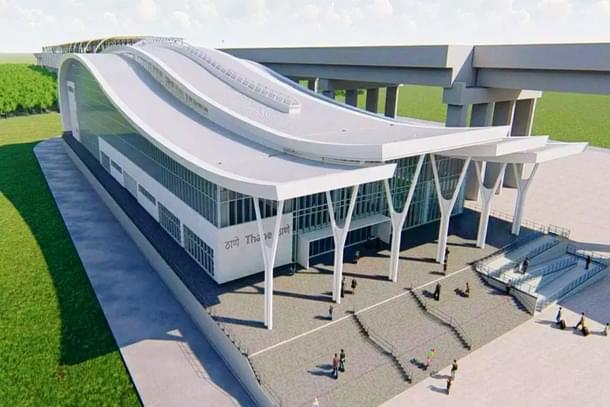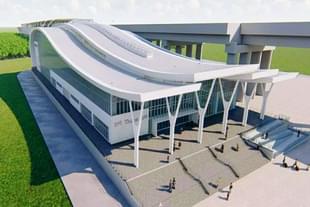Infrastructure
India's First Bullet Train Stations In Making: A Blend Of Gujarat’s Local Art, History, And Modern Infrastructure
V Bhagya Subhashini
Oct 10, 2024, 05:38 PM | Updated Oct 12, 2024, 11:48 PM IST
Save & read from anywhere!
Bookmark stories for easy access on any device or the Swarajya app.


The upcoming Mumbai-Ahmedabad High-Speed Rail (MAHSR) corridor is not just a leap forward in transportation but also a journey through Gujarat’s rich cultural heritage.
As this highly anticipated 508-kilometre-long bullet train project progresses towards its December 2025 deadline, authorities have revealed that each of the eight stations in Gujarat will serve as much more than a transit hub.
From Mahatma Gandhi’s humble charkha to Surat’s glittering diamonds, the stations promise a deep connection with the local identity, showcasing art, history, and landmark achievements.
Local Identity Meets Modern Design
The stations along the MAHSR corridor — Sabarmati, Ahmedabad, Anand, Vadodara, Bharuch, Surat, Bilimora, and Vapi — will reflect the essence of each town, according to the National High Speed Rail Corporation Limited (NHSRCL).
The Sabarmati station, the starting point of the line, takes its inspiration from the iconic charkha, an emblem of Gandhi’s spinning wheel and his vision for India’s independence. Sabarmati Ashram, one of the most sacred landmarks of the freedom struggle, lends both symbolism and sentiment to the station’s design.
Ahmedabad station, which follows, highlights another facet of the city’s cultural wealth. Its front will feature the intricate latticework inspired by the Sidi Saiyyed mosque, a masterpiece of Indo-Islamic architecture. To complement this, the roof will be adorned with hundreds of kites, paying homage to Ahmedabad's vibrant kite festival, according to Indian Express report.
As the train progresses through Gujarat, the stations continue to tell the story of the region. The Anand station, known for India’s dairy revolution, will feature a white exterior and interior design symbolising the district’s renowned Milk and White Revolution, reports Financial Express.
Moving to Vadodara, the city’s abundant banyan trees, which also lend their name to the city (Vad means banyan in Gujarati), inspire the station’s leafy facade.
Bharuch, renowned for its indigenous Sujani weaving tradition, will showcase a station facade replicating the intricate Sujani patterns that have earned the craft a GI (Geographical Indication) tag. Surat’s station, on the other hand, will glisten with diamond-inspired design elements, symbolic of its global status as a diamond polishing hub.
At Bilimora, the city known for its mango orchards, the station will echo the lush greenery of its surroundings, with a fresh mango yellow palette.
Finally, Vapi, which has seen rapid industrial growth, will reflect this transformation with an abstract design symbolising speed and modernisation.
Stations as Vibrant Hubs
Beyond their aesthetic appeal, these stations are envisioned as "vibrant hubs that connect communities," according to NHSRCL Managing Director Vivek Kumar Gupta. He emphasises that the design of each station is meant to evoke pride among the local population by incorporating unique cultural elements.
“Our idea was to pick some elements of the city that the local residents are proud of.” Gupta said.
“For example, Surat is the epicentre of the global diamond industry while Vadodara is known for its abundance of Banyan trees. We have maintained a uniform style at all the stations, but this way, we are redefining the role of transportation infrastructure, turning it into a catalyst for economic growth and cultural vibrancy,” he added.
Gupta also added that the stations are designed not just for transportation but to serve as economic drivers and gathering points for the community. Work has already begun on installing 90 energy-efficient escalators across 12 stations, including two at the Anand station.
These escalators are just one part of the international standards the interiors of the stations will meet, with amenities ranging from business lounges to nursery areas and waiting rooms. Accessibility features, such as wheelchair-friendly designs, lowered ticket counters with Braille instructions, and dedicated spaces for specially abled passengers, are also in place to ensure inclusivity.
Transforming Surrounding Areas
NHSRCL is also looking beyond the stations, planning to develop the areas surrounding these hubs to promote economic growth and improve urban connectivity.
Through Transit-Oriented Development (TOD), authorities aim to transform the regions around key stations like Sabarmati and Surat into thriving commercial and residential zones. By integrating different modes of transport, the bullet train stations will become central hubs for easy and fast travel, whether passengers are commuting locally or embarking on longer journeys.
“The areas around HSR stations at Sabarmati and Surat in Gujarat, and Virar and Thane in Maharashtra, have also been shortlisted by the respective state authorities for preparation of Station Area Development schemes,” Gupta explained.
This vision of TOD aims to blend economic activity with enhanced urban development, ensuring that the bullet train’s impact extends well beyond faster travel.
V Bhagya Subhashini is a staff writer at Swarajya. She tracks infrastructure developments.




